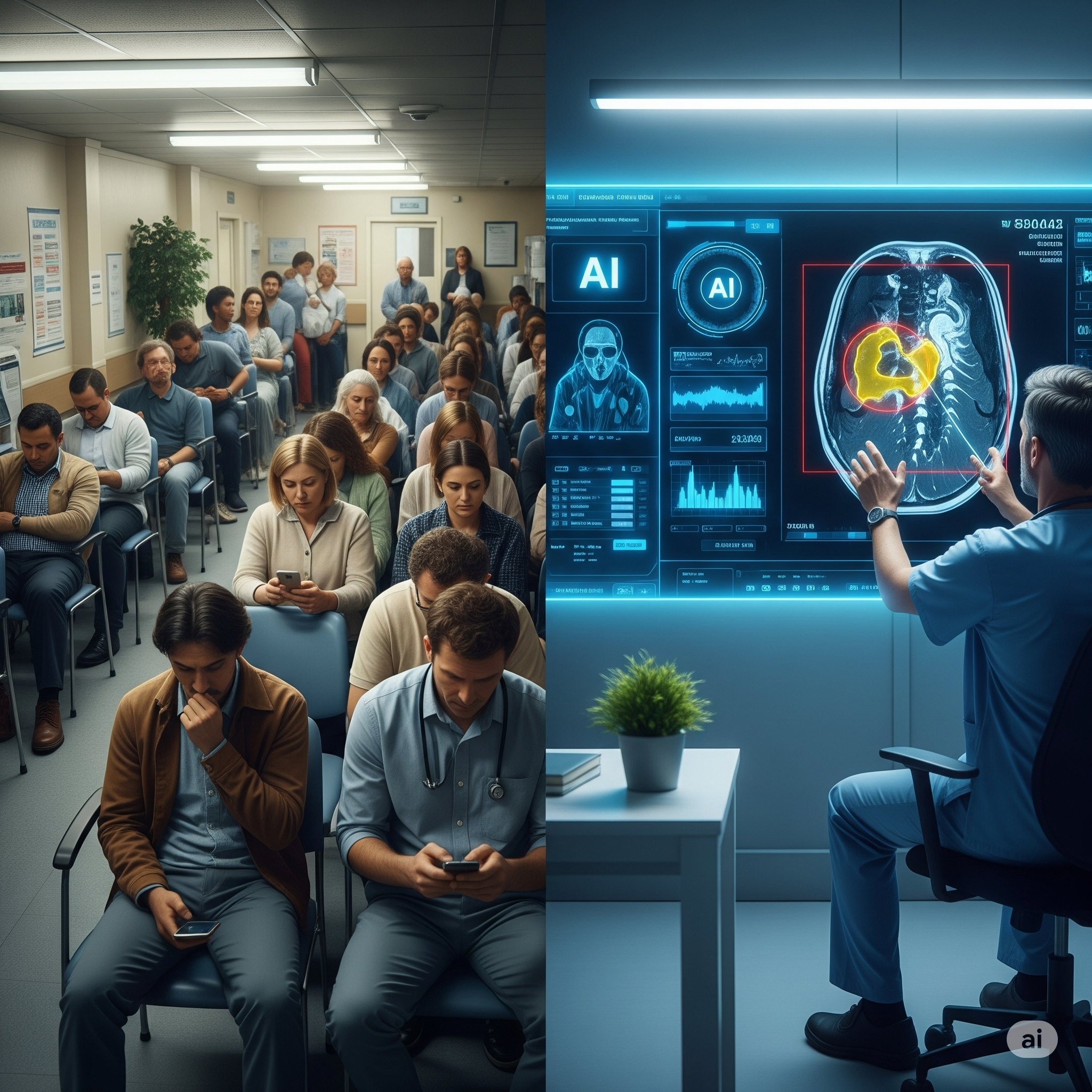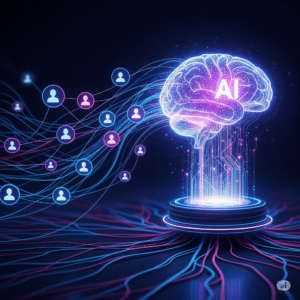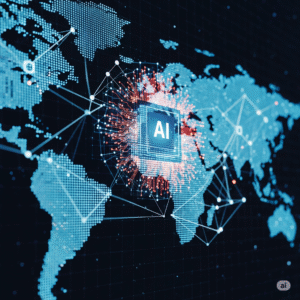We’ve all felt that unique, gut-wrenching anxiety of waiting. Waiting for a test, waiting for a scan, and most agonizingly, waiting for the results. In healthcare, these delays aren’t just frustrating; they can profoundly impact patient outcomes. The bottlenecks in the system—overworked specialists, mountains of data to analyze, and manual processes—have long seemed like an insurmountable challenge. But a technological revolution is underway, and it’s powered by AI in Healthcare Diagnostics. The central question on everyone’s mind is a dramatic one: Can this technology actually replace humans and put an end to these excruciating wait times?
The promise is tantalizing. Imagine a world where a complex MRI scan is analyzed in minutes, not days. A world where critical cases are flagged instantly, pushing them to the front of the line for human review. This isn’t science fiction anymore. The application of AI in Healthcare Diagnostics is actively reshaping the medical landscape. However, the narrative of “AI vs. Doctor” is an oversimplification. The real story is more nuanced, more collaborative, and ultimately, more hopeful. It’s about augmenting our brilliant human experts, not replacing them, to create a system that is faster, smarter, and fundamentally better at reducing wait times.
The Anatomy of a Medical Delay: Why We Are Always Waiting
Before we can appreciate the solution, we must understand the problem. The delays in diagnostics are not typically due to a lack of expertise but a lack of capacity and the sheer volume of data. A single patient’s MRI or CT scan can consist of hundreds, sometimes thousands, of individual images. A pathologist might have dozens of tissue slides to review, each requiring meticulous, time-consuming examination under a microscope. This is where the primary bottlenecks occur.
Every one of these images needs to be analyzed by a highly trained specialist, like a radiologist or pathologist. These experts are a finite resource, facing an ever-increasing workload. This mismatch between the volume of diagnostic tests and the available human capacity is the root cause of the delays we experience. It’s a system under immense pressure, and it’s precisely this pressure point that AI in Healthcare Diagnostics is designed to alleviate, offering a powerful new tool for reducing wait times.
How AI in Healthcare Diagnostics is Actively Reducing Wait Times
Artificial intelligence excels at one thing in particular: recognizing patterns in massive datasets at incredible speeds. In the context of medical diagnostics, this capability is transformative. Instead of replacing the doctor’s decision-making process, AI handles the most time-consuming parts of the analysis, leading to dramatic efficiency gains.
Triage and Prioritization: The First Look with AI in Healthcare Diagnostics
One of the most powerful applications of AI in Healthcare Diagnostics is in smart triage. An AI algorithm can perform a “first look” at hundreds of scans or digital pathology slides simultaneously. It can be trained to identify and flag studies that show signs of critical, time-sensitive conditions—like a stroke, a pulmonary embolism, or aggressive cancer cells.
- Normal Scans: The AI can quickly identify scans with no apparent abnormalities, allowing a radiologist to verify them rapidly.
- Critical Scans: It immediately pushes suspected critical cases to the top of the specialist’s worklist.
This instant prioritization ensures that the most urgent patients get human attention first. This single function is a game-changer for reducing wait times in emergency settings, where every minute counts.
Accelerating Image Analysis with AI in Healthcare Diagnostics
The core of diagnostic work is detailed image analysis. An AI model, trained on millions of annotated medical images, can perform this analysis in a fraction of the time it takes a human. For example, it can automatically measure tumors, quantify biomarkers on a pathology slide, or detect subtle fractures that might be missed on a first human read. This doesn’t mean the AI makes the final diagnosis. Instead, it presents its findings—pre-analyzed and quantified—to the human expert. The doctor can then confirm, reject, or refine the AI’s findings, making their final judgment faster and with more quantitative data at their fingertips.
Case Study 1: Viz.ai and the Race Against Stroke
Stroke is a condition where time is brain. The faster a blood clot can be identified and treated, the better the patient’s chance of a full recovery. Viz.ai developed an FDA-cleared AI platform that integrates with hospital CT scanners. When a patient with a suspected stroke gets a scan, the AI automatically analyzes the images for signs of a large vessel occlusion. If detected, it instantly alerts the entire stroke specialist team on their mobile devices. This process, which can take over an hour manually, now happens in under six minutes. This application of AI in Healthcare Diagnostics is a perfect, life-saving example of reducing wait times when it matters most.
It’s Not a Replacement, It’s a Partnership
The fear of being replaced by a machine is a common theme in the AI discussion, but in medicine, it’s largely unfounded. While AI is incredibly powerful, it has significant limitations. This is why the future isn’t a robot doctor; it’s a human doctor augmented by AI.
The Human Touch: Empathy and Complex Reasoning
An AI algorithm cannot sit with a patient and explain a difficult diagnosis with empathy. It can’t understand a patient’s personal history, lifestyle, and values to recommend a truly personalized treatment plan. Furthermore, AI models are trained on existing data, making them less effective at diagnosing extremely rare diseases or dealing with atypical presentations that don’t fit the established patterns. This is where the intuition, experience, and holistic reasoning of a human doctor are irreplaceable. The goal of AI in Healthcare Diagnostics is to free up doctors from repetitive analysis so they have more time for these uniquely human aspects of care.
Case Study 2: PathAI’s Collaboration in Cancer Diagnostics
Pathology, the study of disease through tissue samples, is another area being transformed by AI. PathAI, a leading company in the field, develops AI models that assist pathologists in diagnosing cancer. Their platform can analyze a digital slide of a tissue biopsy and highlight areas of concern, quantify the density of cancer cells, and identify specific biomarkers. This drastically reduces the time a pathologist needs to spend on each slide. A study in collaboration with Cleveland Clinic showed that using PathAI’s tool helped pathologists reduce their analysis time for certain prostate cancer biopsies by up to 65%, significantly reducing wait times for anxious patients awaiting a diagnosis. The AI didn’t make the diagnosis; it made the human expert faster and more consistent.
A Practical Workflow for Implementing AI in Healthcare
For hospital administrators and clinical leaders, the question is how to begin. Implementing AI in Healthcare Diagnostics requires a thoughtful, strategic approach.
- Identify the Biggest Bottlenecks: Start by analyzing your patient flow data. Where are the longest delays occurring? Is it in radiology, pathology, or another department?
- Select a Specific Use Case: Don’t try to solve everything at once. Choose a single, high-impact problem, such as reducing wait times for mammogram results or stroke detection.
- Partner with a Proven Vendor: Select an AI vendor with clinically validated, FDA-cleared (or equivalent) solutions for your chosen use case.
- Integrate and Train: Work with the vendor to integrate the AI into your existing clinical workflow (e.g., your PACS for radiology). Ensure your staff is thoroughly trained not just on how to use the tool, but on its capabilities and limitations.
- Measure and Optimize: Continuously monitor the impact of the AI tool on key metrics, including diagnostic turnaround times, accuracy rates, and patient outcomes.
Beyond direct diagnostics, hospital operations can also benefit from AI and data analysis. Tools like Microsoft Power BI or Tableau can be used to visualize patient journey data, helping administrators identify and fix non-clinical bottlenecks in scheduling and processing that contribute to delays. Even language models like OpenAI’s ChatGPT can play a role by helping clinicians quickly summarize lengthy research articles or draft patient communication, saving precious time.
The Future of AI in Healthcare Diagnostics
We are only at the beginning of this transformation. The future of AI in Healthcare Diagnostics points towards even more profound changes. As a recent report from McKinsey outlines, we can expect to see AI models that not only diagnose current diseases but also predict future health risks based on a combination of imaging, genetic, and lifestyle data. This shift from reactive to proactive medicine could redefine healthcare as we know it.
The ultimate goal is an integrated system where AI continuously analyzes health data in the background, empowering doctors to intervene earlier and more effectively than ever before. This will be the ultimate achievement in reducing wait times—eliminating the wait altogether by preventing the disease from advancing in the first place.
In conclusion, AI in Healthcare Diagnostics is not about a machine takeover. It’s about a powerful collaboration. The technology is an indispensable tool for tackling the data overload in modern medicine, directly and dramatically reducing wait times for critical diagnoses. The “winner” in the AI vs. Doctor debate is, without a doubt, the patient—who receives a faster, more accurate, and more data-driven diagnosis, all while being guided by an empathetic human expert who is now more empowered than ever.
AI in Healthcare Diagnostics, reducing wait times, AI medical diagnosis, healthcare automation, radiology AI, pathology AI, improving patient flow, AI diagnostic tools, future of healthcare, AI in medicine, patient wait time solutions.
AI in Customer Support is Broken. Here’s the Real Reason Why.



